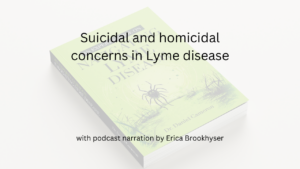Call for your appointment today 914-666-4665 | Mt. Kisco, New York

I will be discussing the Babesia treatment of two USA travelers after returning to South Korea. These cases are being discussed during my Inside Lyme podcast series.
Kwon and her colleague describe the cases of two women, who contracted Lyme disease co-infections while visiting the United States. The cases are discussed in the journal Korean Journal of Parasitology in 2018.
Babesia treatment of the first woman
The first woman was a 50-year-old housewife who was admitted to a hospital in South Korea with a fever, abdominal pain, and nausea.
She had visited a forest in New Jersey, USA four weeks earlier. She described a reddish skin lesion on the right proximal calf area that was suspicious for a tick bite. Two days later, she developed a headache, muscle soreness, fever, and chills.
If she had remained in the US, doctors would have suspected Lyme disease and co-infections.
But now she has traveled to South Korea. In South Korea, doctors are more likely to suspect Malaria since Malaria is endemic to the northern provinces of South Korea. She had a blood smear suspicious for Plasmodium species and an infarction of her spleen. Plasmodium is responsible for Malaria. She was treated with hydroxychloroquine for Malaria.
The subsequent blood tests did not show Malaria.
The doctors looked again at the blood smear. Four Plasmodium-like organisms looked like a Maltese cross seen in Babesia. This is a ring-like structure in the red blood cell in a tetrad-form resembling a Maltese cross. The PCR test was also positive for the Lyme disease co-infection Babesia.
Babesia microti is a parasite carried by the same deer tick that carries Lyme disease.
The woman was started on Babesia treatment. Her fever, abdominal pain, and lab finding resolved within a day of treatment.
[bctt tweet=”Two women who contracted Babesia while traveling to the USA is discussed in the latest Inside Lyme Podcast.” username=”DrDanielCameron”]
Babesia treatment of the second woman
The second woman was 72-year-old. She was evaluated at the same hospital in South Korea with a fever of 99.9.
She was moderately anemic with hemoglobin of 10.8 g/dl. Her platelet numbers were low. Her C-reactive protein and sedimentation rate were high, consistent with inflammation.
Malaria-like organisms were described on her blood smear. Her malaria antigen test was negative.
The doctors looked at the blood again. The doctors found Maltose cross forms in the red cells, the same forms described in the first woman.
The doctors prescribed atovaquone 250 mg/proguanil 100 mg and azithromycin 500 mg. This combination of Babesia treatment is marketed under the name Malarone and Zithromax in the USA.
Her medical condition worsened. She developed a fever, and her lungs were congested.
Her treatment was changed to quinine and clindamycin. This combination of Babesia treatment has been used for severe cases of Babesia, a Lyme disease co-infection. This combination has more side effects than not been used as often due to side effects than atovaquone 250 mg/proguanil 100 mg and azithromycin 500 mg.
She also had a red blood cell exchange. During a red blood cell exchange, doctors remove abnormal red blood cells and replace them with healthy red blood cells derived from blood donors.
Her condition worsened. She was intubated due to respiratory failure.
Doctors added doxycycline for possible co-infection with Lyme disease or Anaplasmosis.
Tests later confirmed the woman had a concurrent infection with Lyme disease. Both the IgG and IgM Western blot tests were positive for Lyme disease.
She died 31 days after admittance to the hospital despite Babesia treatment.
Only eight cases of Babesia infection have been reported in South Korea, 7 of which were imported, notes Kwon.
Kwon cautions both clinicians and travelers. “As the population of traveling abroad increases every year, both physicians and travelers need to be acquainted with not only endemic diseases of their provinces but also with those of other regions.”
What can we learn from these cases?
- Babesiosis can mimic Malaria.
- The onset of Babesia can be delayed. Both of these women developed Babesia treatment weeks after they travel to the USA.
- As the number of travelers abroad increases, it is important to be aware of tick-borne illnesses such as Babesia.
What questions do these cases raise?
- Is there a way to promptly recognize Babesia in an area endemic for Malaria?
- Would earlier identification of Babesia and Lyme disease in the 72-year-old woman have prevented her death?
Treating Tick-Borne Disease
We need more doctors with skills diagnosing and treating tick-borne infections in travelers. We hope that professionals evaluating travelers can use this case to remind them to look for tick-borne illnesses and treat accordingly.
Inside Lyme Podcast Series
This Inside Lyme case series will be discussed on my Facebook and made available on podcast and YouTube. As always, it is your likes, comments, and shares that help spread the word about this series and our work. If you can, please leave a review on iTunes or wherever else you get your podcasts.
Sign up for our newsletter to keep up with our cases.
References:
- Kwon HY, Im JH, Park YK, Durey A, Lee JS, Baek JH. Two Imported Cases of Babesiosis with Complication or Co-Infection with Lyme Disease in Republic of Korea. Korean J Parasitol. 2018;56(6):609-613.




Is there any cure for Babesia?
I start with Malarone and Zithromax I have more recently prescribed tafenoquine https://danielcameronmd.com/treatment-relapsing-babesia/ I have patients do well. Some relapse
I have found Malarone and Zithromax helpful I sometimes have to add other medications ie tafenoquine https://danielcameronmd.com/treatment-relapsing-babesia/. Some relapse